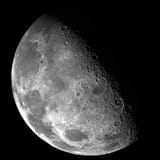Moon Monday #224: A curious find from Chandrayaan 3, Artemis updates, and more
Two announcements before we begin:
- I’m honored to be moderating a fantastic panel on modern themes in global lunar exploration at the international Global Space Exploration Conference (GLEX) on Friday, May 9. If you’re attending GLEX in New Delhi, join us for the session. And, if you’re in India’s space hub Bangalore on Monday, May 12, I’m speaking at the Nehru Planetarium about recent scientific results from India’s Chandrayaan 2 and 3 missions as part of Galaxy Forum India. 🚀
- Moon Monday will be off the coming Monday since I’m attending as well as speaking at these two back-to-back conferences in two cities. Naturally, May 19’s Moon Monday will cover all major global lunar exploration updates between now and then so you won’t miss anything. I will also share any notable updates from said conferences that maybe of wider interest. 🌗
India’s Chandrayaan 3 rover may or may not have stumbled upon the Moon’s mantle material
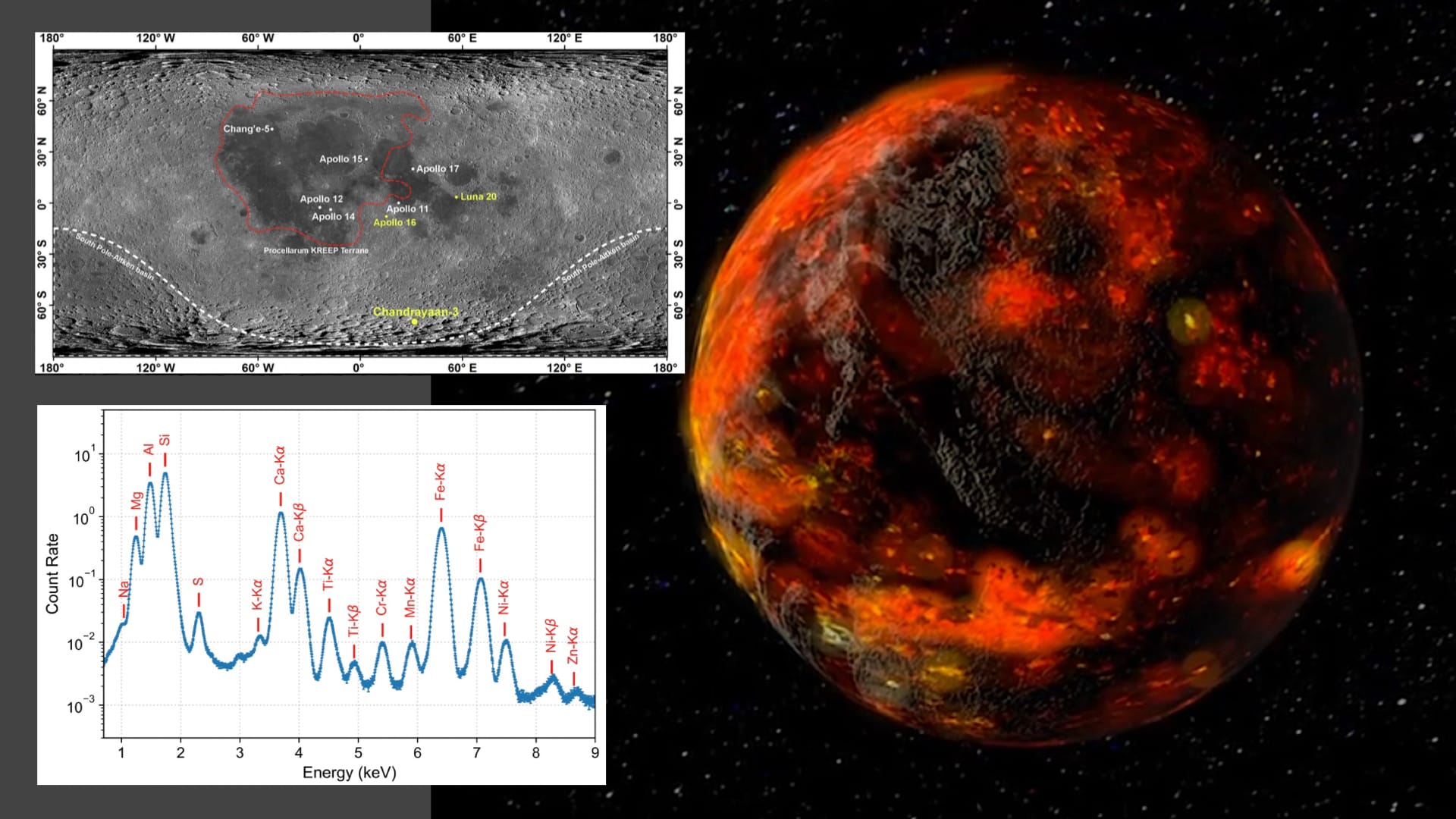
Scientists analyzing the elemental composition of our Moon’s southern high-latitude surface as measured by ISRO’s Chandrayaan 3 rover have concluded that the excess sulfur detected in the landing site’s soil and rocks compared to other regions likely originated in the Moon’s mantle. After rejecting or accommodating other mechanisms known to enhance sulfur in the lunar soil, the authors of the paper published in Nature surmise that the majority of these sulfur-enhanced materials would’ve likely gotten deposited in the Chandrayaan 3 landing region by the massive South-Pole Aitken (SPA) basin impact roughly 200 million years after our Moon’s formation. The SPA’s impactor is thought to have excavated material from more than 100 kilometers below the Moon’s surface, altering the evolution of our Moon’s farside and south pole.
Note that unlike media reports calling the Chandrayaan 3 rover’s curious finds as definitively being material from the Moon’s mantle, it’s not a certainty. Even if the materials may have originated from the lunar interior, they might be from the lower crust instead of the mantle, for example. We need direct sample collection and analysis to confirm or constrain their origin. Either way, it’s important to remember that ISRO optimized the Chandrayaan 3 rover’s traverse path heavily for engineering safety rather than scientific return, more so than your typical tradeoff in a planetary science mission due it being India’s first extraterrestrial rover. Furthermore, having faced more roving difficulties than expected due to the high-latitude lunar environment and uneven local topography, the rover moved only about 100 meters from the lander, which is shorter than the originally expected drive of 300–400 meters. There’s no doubt that more elemental measurements from distinct areas in the landing region would’ve increased Chandrayaan 3’s scientific oomph. With India’s lunar landing and roving technological foundations set though, measurements from the upcoming complex and capable Chandrayaan 4 and Chandrayaan 5 / LUPEX missions should be very exciting from a scientific standpoint.
In any case, finding the sulfur-enhanced materials certainly add the Chandrayaan 3 landing region to the list of potential mantle sampling locations on the Moon, expanding said scope. The findings are also important in another way as explained in the paper:
Prior to ISRO’s Chandrayaan-3 mission, there were no in-situ volatile abundance measurements from the lunar southern high-latitude highlands. Consequently, our understanding of the variations in the concentrations of volatiles across the lunar surface is constrained by the limited scope of measurements obtained primarily from lunar samples collected from equatorial regions. This points to a substantial gap in our understanding of the mechanisms governing enrichment-depletion of volatiles such as sodium (Na), potassium (K) and sulfur (S) on the Moon.
Relatedly, the first geological map of Chandrayaan 3’s landing region was published recently. It revealed the region to be 3.7 billion years old, and that it has been significantly altered since its formation by subsequent crater impacts and their material ejections. Another paper posited specifically that Chandrayaan 3’s landing site lies atop an ancient crater spanning about 160 kilometers across and being up to 4.4 kilometers deep. This inference is primarily based on ejecta trails around the landing site as imaged by the mission’s Pragyan rover coupled with high-resolution views of the larger region from the Chandrayaan 2 orbiter.
A related study of Chang’e 6 Moon samples published in Nature recently added to the long march of notable scientific results from the Chinese mission and continued anchoring events in our Moon’s evolution. This study involved analyzing 578 particles weighing a total of 5 grams. It revealed for the first time that the Moon’s farside mantle contains less water than within the nearside, adding to the debate on the topic by lending firm and unique credence to the hypothesis that our Moon indeed lost most of its water during its fiery formation. CASC’s news release on the study noted how Francis McCubbin, NASA’s Astromaterials Curator and a peer reviewer of the paper, called the work “a landmark study on the water abundance of the lunar farside.”
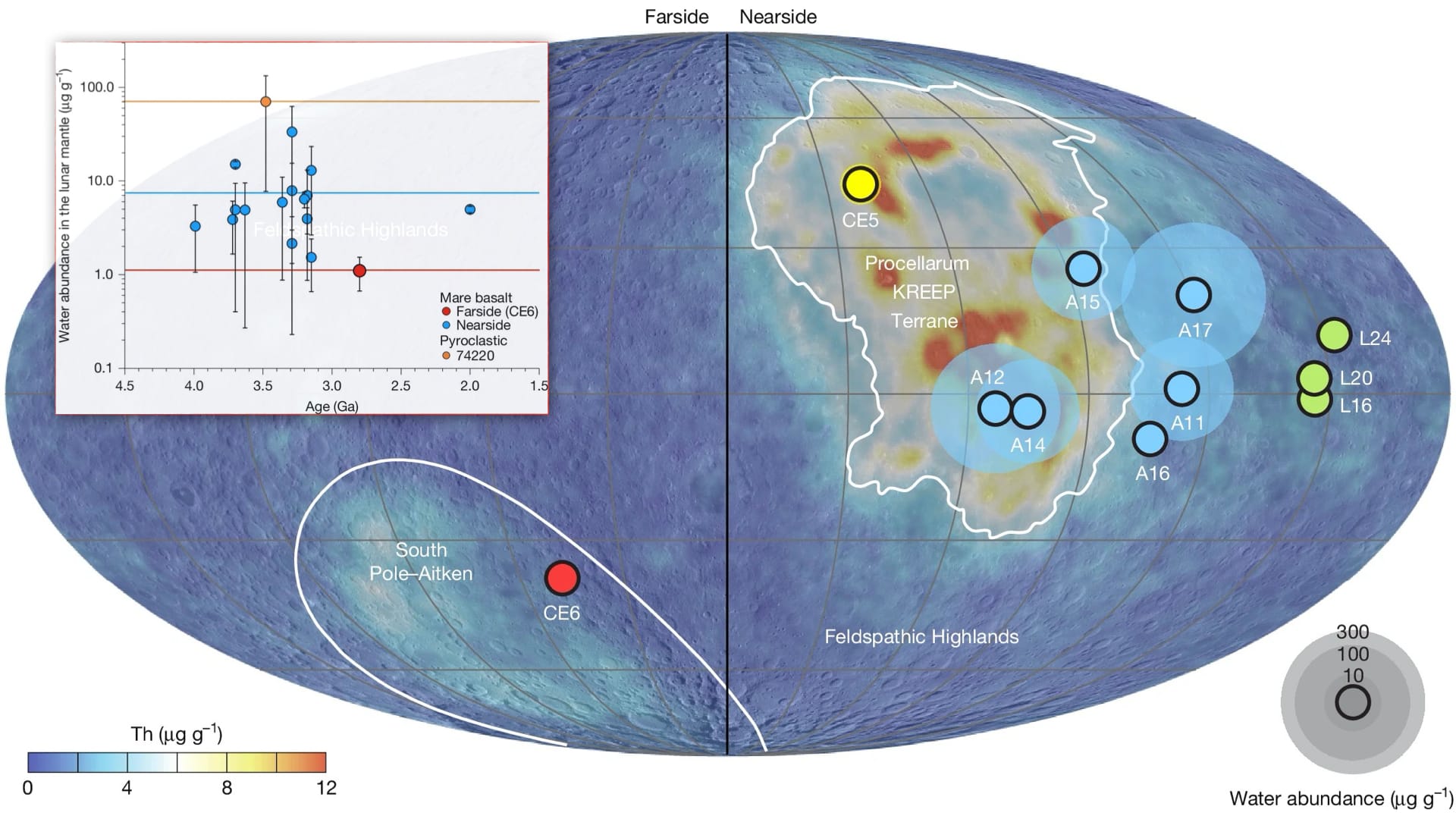
Many thanks to Open Lunar Foundation and Astrolab for sponsoring this week’s Moon Monday! If you too appreciate my efforts to bring you this curated community resource for free and without ads, support my independent writing. 🌙
Artemis updates
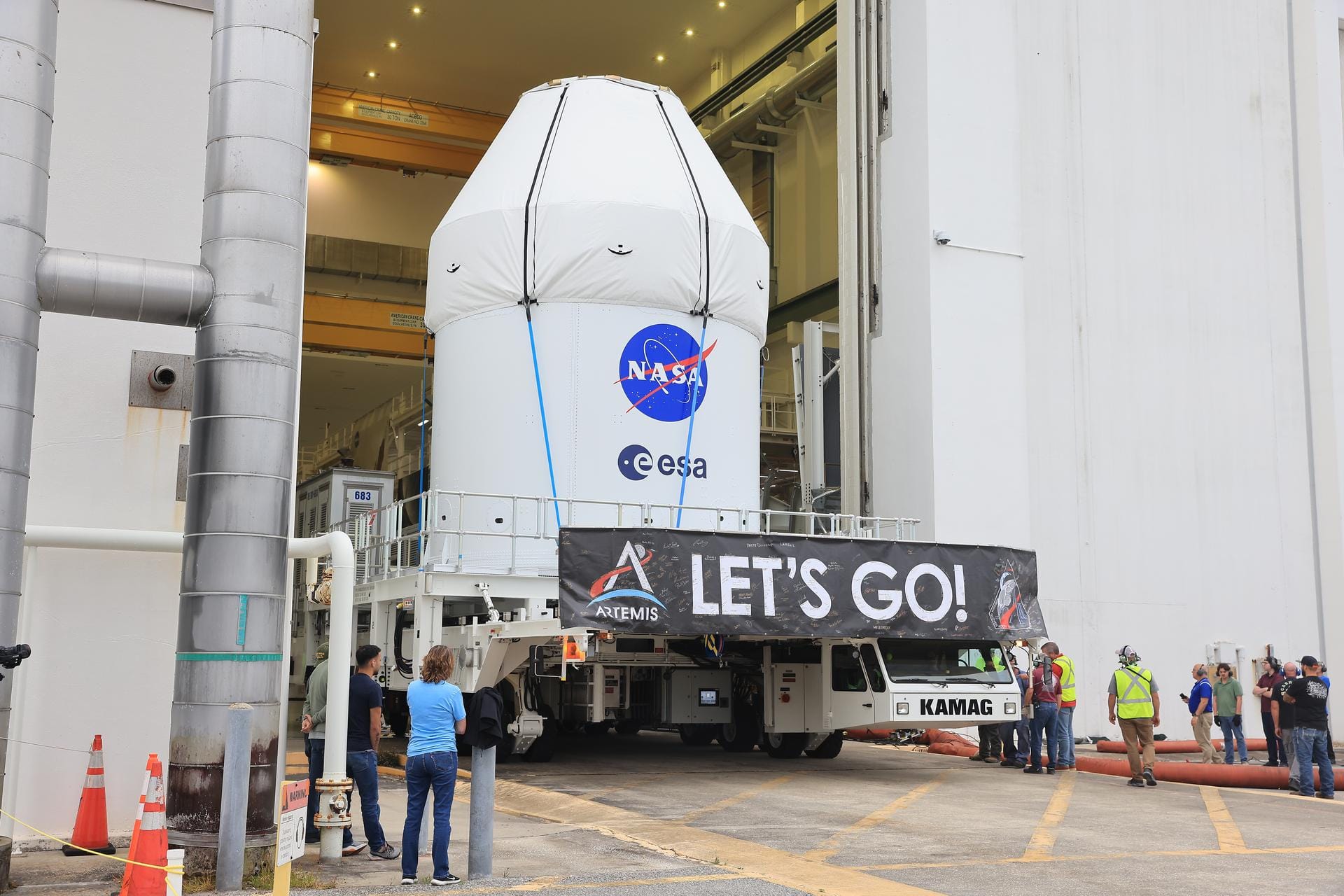
On May 2, the Trump administration released its Presidential budget request for NASA for FY 2026, proposing a historic ~25% cut to NASA’s budget but which continues support for crewed Artemis II and Artemis III missions as planned so as to try landing on the Moon before China attempts the same by 2030. Notably, the budget request proposes cancelling the “grossly expensive” SLS rocket and Orion crew capsule from Artemis IV onward in favor of as-yet-unspecified commercial alternatives. It also proposes canceling the NASA-led international Gateway lunar orbital habitat, suggesting that its already-developed elements by the US and its international partners be repurposed for other [unspecified] missions. The budget request essentially wants to redirect existing funds from the International Space Station and elements of Artemis that are being proposed for cancellation towards commercial Moon and Mars missions instead. The US Congress will review these proposals in the coming months and will need to approve them to become reality.
These updates fall in line with the recent insistence by Jared Isaacman, Trump’s nominee for the NASA Administrator position, that the US should pursue the Moon and Mars in parallel. Notably, NASA’s FY2026 presidential budget request does not allocate any funds or missions to directly find and study lunar water even though the US has been failing at this central goal of Artemis.
In the meanwhile, preparations continue to fly the four Artemis II astronauts around the Moon and back next year. Technicians working at NASA completed integrating the SLS rocket’s upper stage atop the core stage on May 1. On March 23, technicians had joined the twin solid rocket boosters to either side of the SLS’s core stage. Also on May 1, Lockheed Martin delivered the mission’s Orion crew capsule to NASA for further processing and assembly.
As a mildly interesting aside, Stephen Clark reports that NASA swapped one of the four core stage engines on the Artemis II SLS rocket after discovering a hydraulic leak in the engine’s oxidizer valve actuator. Another aside: Artemis II will also fly a CubeSat each from Germany and South Korea.
More mission updates
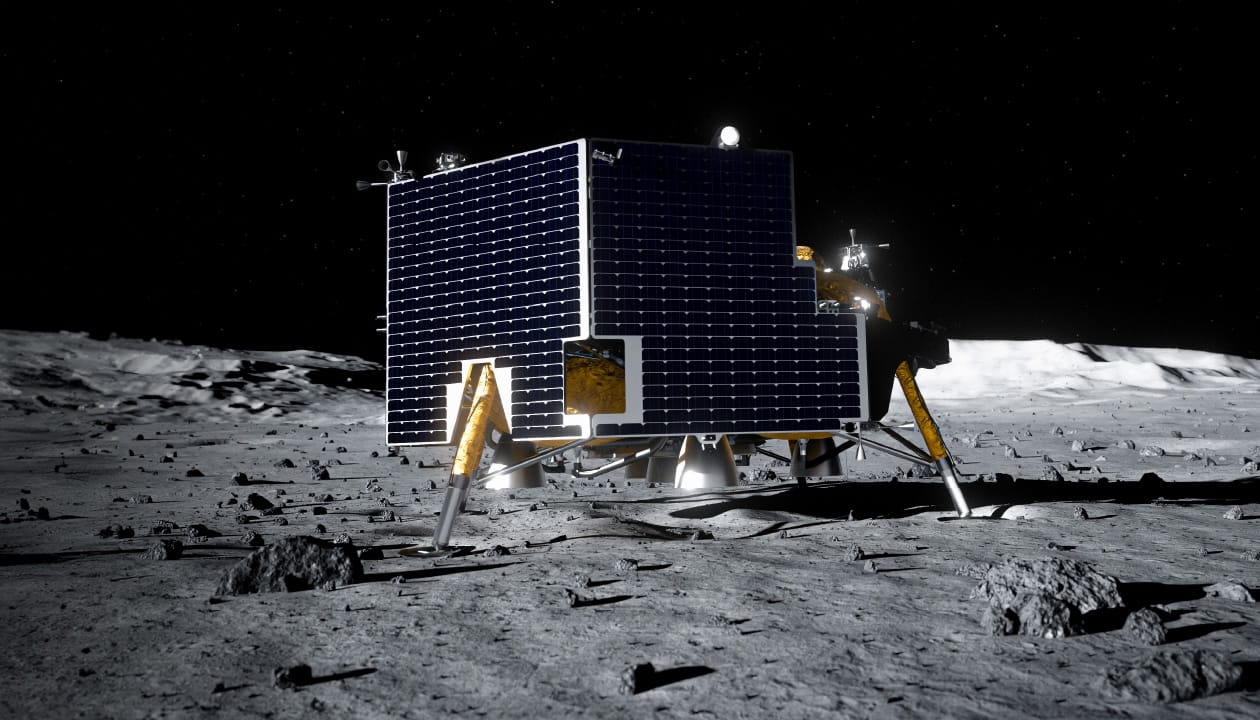
- By flying lunar sensors and associated computing units on a helicopter as well as the Xodiac vertical-takeoff vertical-landing rocket system over a simulated lunar terrain, Astrobotic completed testing their lunar navigation and guidance systems that will fly to the Moon on the company’s upcoming Griffin lander as part of NASA’s CLPS program. The large lander’s primary payload will be the FLIP rover by Astrolab (a Moon Monday sponsor), which got manifested recently after NASA decided not to fly the VIPER rover aboard Griffin.
- TASS reports that as part of a meeting of the space agency heads of BRICS countries, the Roscosmos Chief Dmitry Bakanov stated that Russia’s lunar exploration plans involve launching the polar reconnaissance orbiters of Luna 26 and Luna 29 respectively as well as the Moon landers of Luna 27, 28 and 30. Bakanov added that Russia plans on contributing an electric power station to the China-led ILRS Moonbase project. Luna 26’s primary goal after launching circa 2027 is to map our Moon’s surface in multiple wavelengths at high resolutions from altitudes as low as 50 to 80 kilometers. This will particularly help scientists better grasp the distribution of water ice on the Moon’s poles, which is useful data to help plan the China-led ILRS Moonbase project with Russia as a member. Another major goal of Luna 26 is to measure and characterize the radiation and plasma environment around the Moon. The list of Luna 26’s instruments is given below.
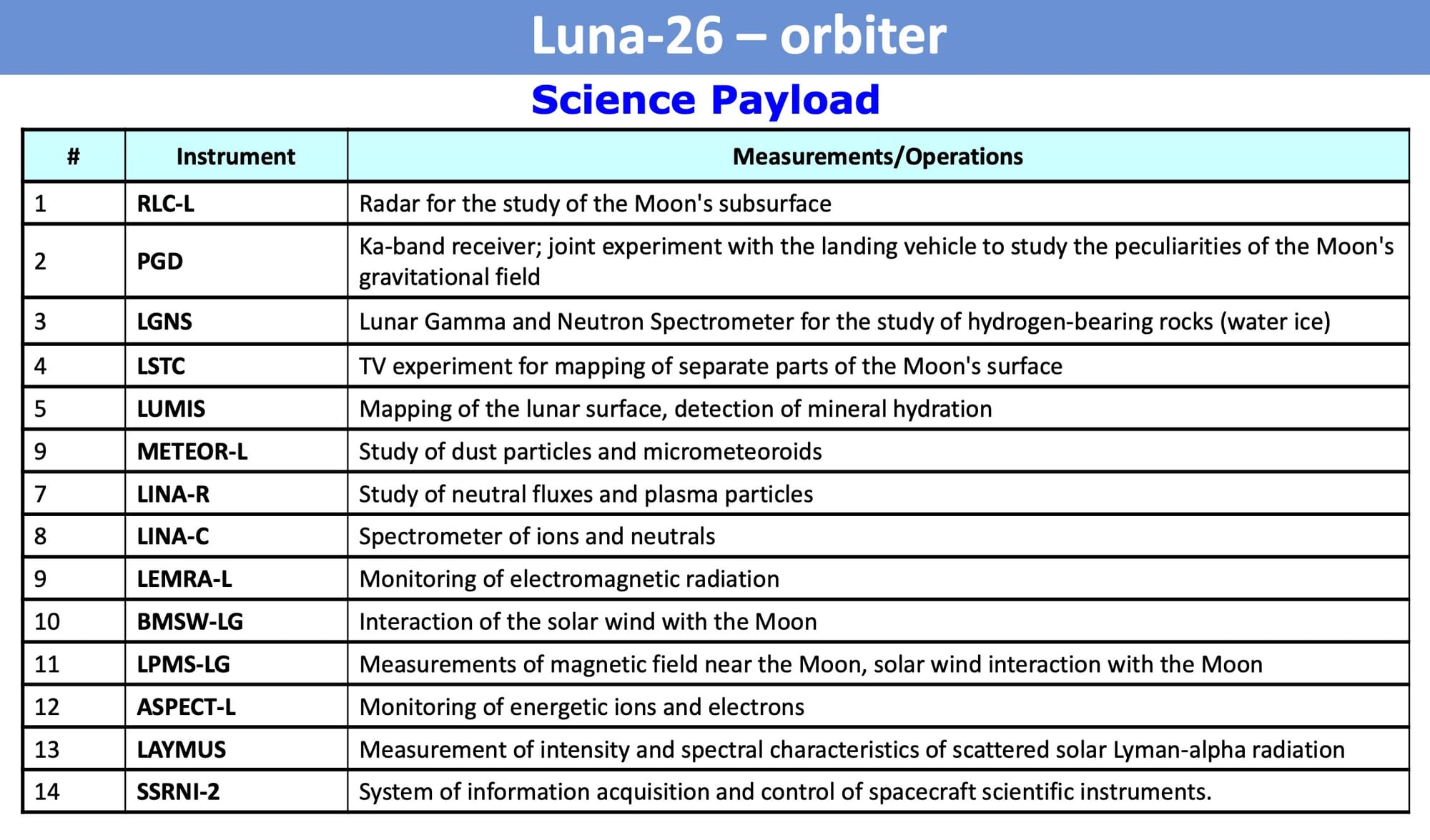
- ispace has been selected as part of Japan’s 1-trillion yen “Space Strategy Fund” initiative to deploy a lunar orbiter which will use a terahertz wave sensor system to locate and map water ice deposits on the Moon’s poles. Data from this orbiter will be analyzed in tandem with direct surface and subsurface measurements made by the upcoming Indo-Japanese LUPEX rover mission.
